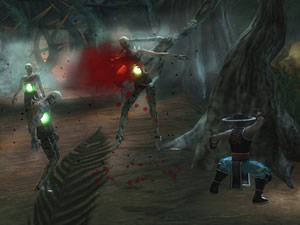You have not offended the Shaolin temple.
Action games based on fighting franchises lead to terrible things. Bad control, bad plots and bad gameplay have routinely marred this fruitless plan. It’s a crime against gaming nature, like trying to breed a Nintendo fanboy with, well, anything. After several gruesome experiments, has Midway finally discovered the dark ritual to successfully merge the two?
Indeed. Behold the abomination!
The same blood that washed the walls of its fighter forebears pumps through Mortal Kombat: Shaolin Monk‘s gameplay, but the body of the beast has evolved. Arcade mode, the wimpy thorax of the fighting game, has been replaced by a long, serpentine tail of a beat-em-up campaign. Atop this tail have been placed twin, grim heads of single and cooperative play, and when gamers aren’t busy obliterating enemy fodder, they can turn on one another in the game’s Versus mode.
Shaolin Monks, then, is a versatile animal, capable of ripping through the hours in more ways than any Kombat before it. But as is often the case with acts of mad science, the operation responsible for this deviation was far from clean. Scars and flaws cover areas where its creators were either too busy or too insane to patch things up properly.
And as neat as some weird surgery involving tails and thoraxes sounds, the tale told in Shaolin Monks is awful. Some hunchbacked Midway employee must have been in an awful hurry to dig up a story, because this pretty much decomposes before your very eyes.
At the end of the first Mortal Kombat game, the heroes defeat Shang Tsung and drive him from Earth realm. According to Shaolin Monks, Tsung then challenges Raiden, kicks his ass, assumes his guise and sends Liu Kang and Kung Lao on a bunch of errands in the Outworld.
The tale twists – sort of – when Shang Tsung reveals himself and tells the two warriors that they have been doing the bidding of his master, Shao Khan. But you, the player, already knew this thanks to a handy cut-scene explaining it right from the start. The only thing that’s truly shocking is the inability of the warriors to figure out the truth before Shang Tsung spells it out for them.
What you’re actually doing for Shao Khan, though, remains a mystery even after you kick his ass into little pieces. All you know is that you’ve just killed a thousand people with your bare hands, and this giant, WWF reject wants to put his entire empire on the line by fighting you. Whatever, his funeral.
The real story is the game’s over-the-top, solid action. Shaolin Monks is a three-dimensional beat-em-up with some veins borrowed from games like Final Fight. You choose to fight as either Liu Kang or Kung Lao (don’t worry, they aren’t as similar as their names make them sound), and run through 3D environments lifted from previous Kombats while dispatching waves of Outworld enemies with simple but effective combos.
While the soul of the button-masher wasn’t entirely exorcised here, your attacks at least come in three flavors: quick, knockdown, and launcher. Quick attacks can be linked together for a long, decent combo, launchers knock enemies into the air for juggling, and knockdowns tend to slam your enemies into the ground. Each type has its own face button, so you can easily chain together some awesome combos instead of just mashing the same attack repeatedly.
Things literally take off when you knock enemies into the air. You can jump after them, beat on them a bit, knock them even higher into the air, bounce them off the ground and finally throw them into the bed of spikes that looks coziest. While you can’t rip into opponents as deeply as you could in the fighting games, you can still ruin their lives in oodles of gooey ways, and there are hundreds – if not thousands – of virtual lives to end.
There are also buttons for blocking and throwing as well as one that acts like a Shift key, turning your normal attacks into special moves. For Liu Kang this means a fireball, flying kick, and a powerful uppercut. Blocking and special moves are governed by a power meter that depletes with use and refills when you run. The only downer here is the fact that you can’t execute special moves in midair.
If you tire of beating your enemies lifeless, you can always cut them into little pieces with any bladed weapons you find lying about. While the combos here are pretty limited, every once in a while you’ll attack an enemy and a corner of his head, or the whole thing, will pop off like a grape. Fatality!
Speaking of which, as you beat on baddies, your Fatality meter fills up. Once full (of blood, of course), you can initiate a fatality by entering the right combo. You learn these by completing various combos and doing other cool things to enemies. Watch with delight as your character rips a head off here or kicks off some balls there.
 Sometimes you’ll wind up exposing an enemy’s brains, which is always a shocker since your foes never exhibit any kind of intelligence. They’re always on attack mode and most have one or two strikes they’ll throw at you constantly. The difficulty lies in the fact that some of these attacks are pretty gnarly, like setting you on fire.
Sometimes you’ll wind up exposing an enemy’s brains, which is always a shocker since your foes never exhibit any kind of intelligence. They’re always on attack mode and most have one or two strikes they’ll throw at you constantly. The difficulty lies in the fact that some of these attacks are pretty gnarly, like setting you on fire.
The boss battles are excellent. You get the classic Mortal Kombat feel of squaring off against Baraka, for example, but now he’s the master of his own level and can do things befitting a boss. When you rough him up a little, he’ll leap out of the fight, grab an innocent monk, and hurl him into a nearby fire. The monk will run out into the arena screaming and burning, transformed from a mild-mannered holy-man into a psychotic, flaming demon. Must have been the Kool-Aid.
Bosses aren’t the only ones who can use environmental hazards to their advantage, though. Shaolin Monks is bristling with spikes, cliffs, meat grinders, acid pools, hooks, hungry trees and angry serpents. These hazards serve one of two purposes: either they provide an easy means of dispatching your enemies, or they act as a macabre lever for a puzzle. If a door is closed in a room, for example, it means you need to knock somebody into something sharp. Since you’ll naturally want to knock enemies into all the sharp objects you can find, half the time you’ll solve puzzles before you even knew they were there.
When you do run into actual levers, engaging them requires a Test Your Might challenge, which means rapidly tapping a button within a time limit. At first this seems cool since it puts yet another MK mainstay into an action game perspective. Then the game puts you through four of “em in a row as sort of a middle-finger to your fingers.
For the most part, though, the game’s environmental design is fine. There’s a central hub, known as the Portals, through which every area in the game can be accessed. In the beginning, only one area is open, the rest being blocked by obstacles that can only be overcome when you’ve learned a certain skill.
However, the game’s progression is limited by the fact that you only gain one skill per boss fight, and each skill only unlocks one new area, so the experience is extremely linear. While your forward progression is limited, you can revisit any area in the game, many of which contain secret areas that can’t be accessed the first time through. As you gain new powers, you can run back through the game and grab all the little unlockables you missed. It’s a cool means of providing unlockable content, but we wish going back to old areas with new powers actually led to more new areas, like in Metroid.
Besides, many of the best unlockables can simply be purchased. When you kill enemies you gain experience points, essentially cash for new combos and upgrades. It’s not very deep, but it’s better than most straight-up brawlers.
The moves you learn upon defeating bosses also figure in Shaolin Monks‘ platforming scheme. Between rooms filled with enemies, you’ll occasionally happen upon a platform segment requiring you to hop around like Mario while avoiding green flaming skulls. We don’t know why the developers decided to bind such a weird appendage to the body of their beast, but hopefully in the next evolution of this creature, it will have fallen off, since it sucks.
While there is only one path through the game, you can traverse it by yourself or cooperatively. Unfortunately, these modes are completely separate and cannot be brought together, even through the darkest rituals. If you’re playing single-player mode and a friend comes over and wants to jump in, you have to quit what you’re doing and start a completely new game. The upside of this is that the enemies are a lot tougher in co-op mode, keeping the challenge level relatively even with the single-player mode. The downside is that you have to keep track of two separate but identical games.
 If you and your friend can’t agree over who gets to be Liu Kang, you can resolve your dispute the right way: in Versus mode. Only Liu Kang and Kung Lao are available in this mode from the start, although you can quickly unlock more playable characters by advancing in the campaign. The gameplay is the same as that of the other modes, putting two combatants in lethal arenas full of weapons and power-ups. Environmental hazards abound, from cliffs to spikes to random chunks of flying rock, and it’s always fun to introduce these to your friends.
If you and your friend can’t agree over who gets to be Liu Kang, you can resolve your dispute the right way: in Versus mode. Only Liu Kang and Kung Lao are available in this mode from the start, although you can quickly unlock more playable characters by advancing in the campaign. The gameplay is the same as that of the other modes, putting two combatants in lethal arenas full of weapons and power-ups. Environmental hazards abound, from cliffs to spikes to random chunks of flying rock, and it’s always fun to introduce these to your friends.
Less entertaining is the fact that some of the unlockable characters are basically just skins. Scorpion, for example, is Liu Kang. Sure, he has a teleport jump kick and signature “get over here” harpoon, but his normal attacks, combos and throws are identical to Liu’s, and if you use him to replay Story mode he’s even referred to as Liu Kang in the cinematics. Next time, Midway, heed your own advice and finish him.
The graphics tend to be good when it matters; namely, when you’re kicking enemies into the air and bouncing them off the ground. The framerate unfortunately dips beneath the twenties when you’re fighting a lot of enemies, and in co-operative mode the camera occasionally zooms out so far that player characters and enemies are reduced to stacks of beige pixels. These issues are equally present in both the PS2 and Xbox versions, although the Xbox version predictably loads and saves a lot faster. For the most part, though, things look and sound fine when you’re playing.
The cut-scenes, though, are bad in a way that is more painful than funny. The voice-acting is terrible, the lip-synching nonexistent, the gesticulations loop awkwardly, the visual effects are dated and the story is retarded. They are, in their complete ineptitude, a little endearing. After all, no one wants to be mean to anything so obviously retarded.
Besides, Mortal Kombat: Shaolin Monks is still a fairly impressive beast. It might not be smart, polished or new, but it’s wonderfully violent, varied and bloody. Plus, it’s proof that two heads are better than one.
-
Mooortal Kommmbaaat!
-
Vicious and bloody!
-
Mortal Ko-op
-
Graphical flaws
-
Stupid story
-
Linear











